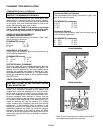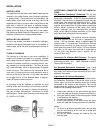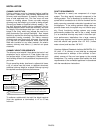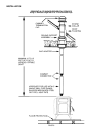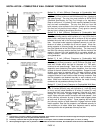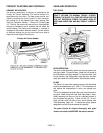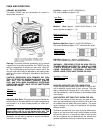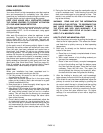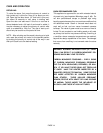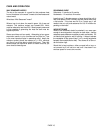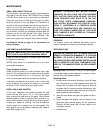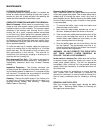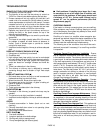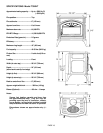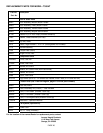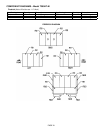
CARE AND OPERATION
PAGE 14
REFUELING
To refuel the stove, first move the primary air control to
high (pulled out). Let the fire "liven up" for about one min-
ute. Open the fuel door about 1/2" and hold in this posi-
tion about 30 seconds or until stove is drafting well.
Open the door and add wood. If the fire or coal bed is
almost depleted and a full load of cord wood is added, it
may be necessary to adjust the primary air control wide
open to re-establish a lively fire. The use of start-up air
should only be used for a short period of time.
NOTE: After refueling and the wood is burning at a brisk
rate, reset the primary air control to the desired position
by pushing the primary air control rod all the way in and
then pull it back out to the desired setting.
BURN RECOMMENDED FUEL
This appliance is approved for use with untreated natural
dry wood only (see Important Warnings, page 2, #8). Do
not burn particleboard scraps or pressed logs using
bonding agents because they can produce conditions that
will deteriorate metal. Green or uncured wood does not
work well as fuel, and can cause increased creosote
buildups. The value of green wood as a source of heat is
limited. Do not overload or use kindling wood or mill ends
as primary fuel as this may cause overfiring. Overfiring is
a condition where excessive temperatures are reached,
beyond the design capabilities of the stove. The damage
that occurs from overfiring is not covered under the stove
warranty.
WARNING: BURNING IMPROPER FUEL (I.E. CHAR-
COAL) CAN RESULT IN CARBON MONOXIDE POI-
SONING WHICH MAY LEAD TO DEATH!
CARBON MONOXIDE POISONING – EARLY SIGNS
OF CARBON MONOXIDE POISONING RESEMBLE
THE FLU WITH HEADACHES, DIZZINESS, OR NAU-
SEA. IF YOU HAVE THESE SIGNS, GET FRESH AIR
AT ONCE! HAVE THE HEATER INSPECTED BY A
QUALIFIED SERVICE TECHNICIAN. SOME PEOPLE
ARE MORE AFFECTED BY CARBON MONOXIDE
THAN OTHERS. THESE INCLUDE PREGNANT
WOMEN, PEOPLE WITH HEART OR LUNG DISEASE
OR ANEMIA, THOSE UNDER THE INFLUENCE OF
ALCOHOL, AND THOSE AT HIGH ALTITUDES.



